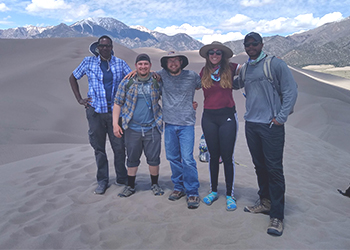MSU Texas’ Katumwehe receives National Science Foundation grant
The gold did more than pay for Katumwehe’s education. It fostered a wonder of rocks and how they form, and of the dynamics that shape the continents. Now Assistant Professor of Geosciences at Midwestern State University, Katumwehe studies those forces deep inside the Earth, forces strong enough to break continents apart. Where does that force come from?
With the help of a $184,066 grant from the National Science Foundation, Katumwehe will search for answers to his questions. The grant is a four-year project to study dry rifting in the Albertine-Rhino Graben in Uganda. The project includes collaborators from Virginia Tech, the University of Delaware, the University of Kansas, Northwestern University, University of Leicester United Kingdom, and Woods Hole Oceanographic Institution. MSU Texas and Ugandan graduate student researchers also will be involved in both the field and lab. Each member of the group has a special area of research and will meet to compare notes throughout the next four years. This is the first time for MSU Texas to have a research collaboration with an African nation.
Dr. Jon Price, Chair of the Kimbell School of Geosciences, said it was hard for him to contain his enthusiasm for Katumwehe’s accomplishment in receiving the grant, and the significance of the grant for the Kimbell School at MSU Texas. “In his second year at MSU, Dr. Katumwehe has been awarded a substantial NSF research grant, succeeding in the midst of fierce competition for limited funding. In doing so, he’s found the resources to engage in top-tier research in one of the most active environments on our planet, one that underpins our understanding of Earth dynamics.”
The area of study is the western branch of the East African Albertine rift, near where Katumwehe grew up. He compared the continent to a car windshield. A crack might start at one spot, then continue, stop, then continue and stop again. “It zig zags in a pattern. The same applies to continents,” he said. “Most of the time in continental breaks, volcanoes are involved. But in this area, there’s hardly any evidence of volcanoes, and all the information we have now is based on the presence of volcanoes.”
He and his fellow researchers want to understand how those rifts, fractures of the earth’s surface, can form without heat. “Heat of some sort is involved but the heat has not come to the surface. The hypothesis is that the heat is still deep-seated. When you have heat at the base, it may not be obvious at the surface, but it does affect the surface through features such as grabens, or depressions in the earth,” Katumwehe said. “What is the transport mechanism for this heat?”
Although the area does not have volcanoes, it does have earthquakes. Studying why the earthquakes happen will help builders design future construction that withstand the quakes.
This area of continental breakup also is rich in oil and gas deposits but the continental rifts are not old, so where did the heat needed for oil maturation come from? Katumwehe hopes his research can help explorers understand how the oil forms, which will make the deposits easier to find, and in turn help the economy of his homeland.
Katumwehe is excited about the opportunities that the grant will give his students. “I love to see students involved in research and presenting their findings. It’s a big motivation.” Geophysics students in Uganda will be trained on how to do research. “The first year we’ll be doing the training. This group will be involved in data acquisition and they will see how data is processed,” Katumwehe said. Then MSU Texas students will make trips to Uganda. “They’ll see different cultures and interact with Ugandan students. Research abroad is unique. It will be an experience for them.” Katumwehe said that the area is beautiful, with several national parks and native wildlife.

Andrew Katumwehe with MSU Texas graduate students Lorenzo Carranza, Evin Parker, Hannah Ghotbi (of Oklahoma State University), and Jaelene Lewis on a field trip to Colorado sand dunes.
The team will gather and process data, then present it at conferences of the American Geophysical Union and GSA conferences. MSU Texas has a memorandum of understanding with Makerere University in Uganda and the Ugandan government, which has given a green light for the research. “Dr. Katumwehe is enabling our students to adopt projects that will have a profound impact on the whole of Earth science,” Price said.
Along with Katumwehe’s personal excitement for the grant, he also is excited for MSU Texas. “This puts MSU’s profile out there as university that is involved in research.” He gives credit to Price and Dr. Marcy Brown Marsden, Dean of the McCoy School of Science, Mathematics & Engineering. “Dr. Brown Marsden was instrumental in kick-starting this project. She allowed me to attend a conference where I met the other researchers and saw this project was feasible,” he said. “And Jon is always giving me a green light, keeping me focused, and encouraging collaboration.”
He also praised MSU Texas’ administration. “If you don’t have an administration that cares for their employees, this doesn’t happen. This enables you to explore your potential to see how far you can go,” Katumwehe said.
It’s been 14 years since Katumwehe has been to his homeland, where his wonder of the Earth’s mysteries began. “The pursuit of gold has its fortunes and misfortunes. Gold took my family to school. Now I’m looking forward to helping students begin their own adventure of research,” he said.
